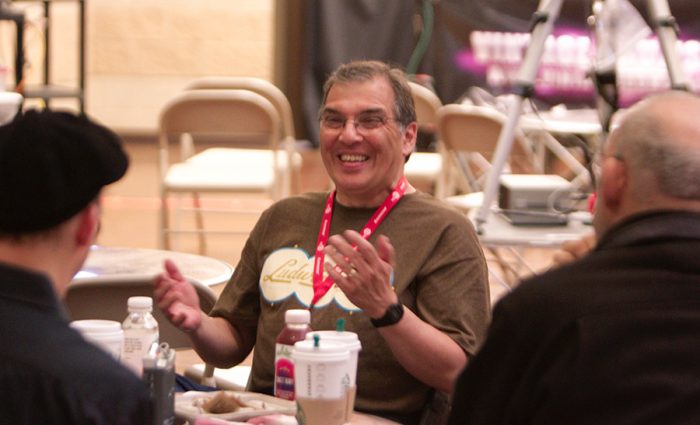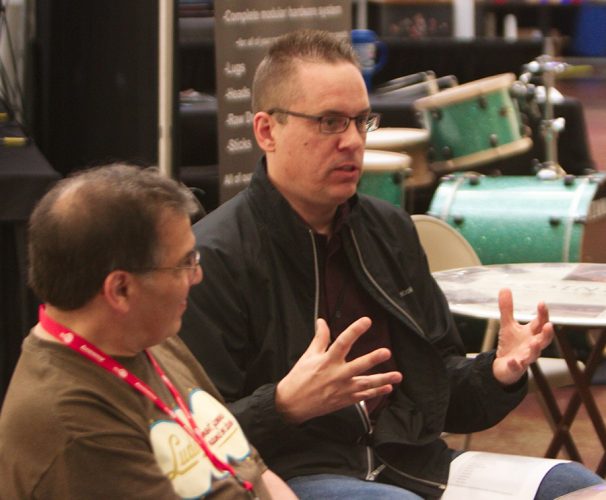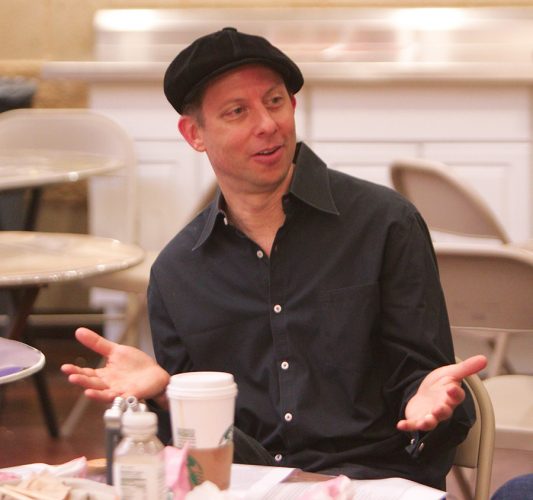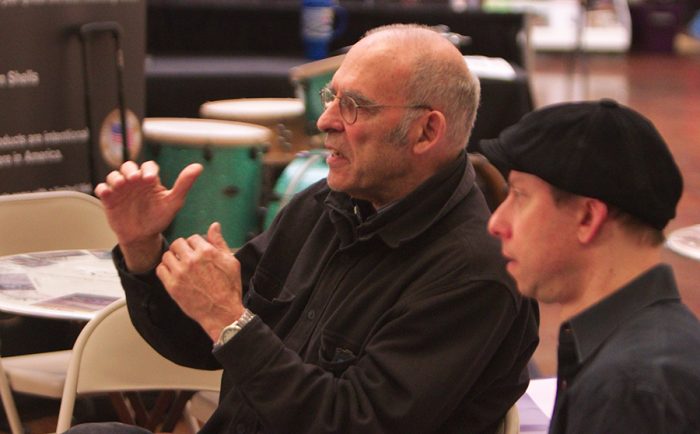BY ANDY DOERSCHUK & PHIL HOOD | PHOTOGRAPHY BY MIKE HACALA | FROM THE AUGUST 2015 ISSUE OF DRUM!
There are few places on Earth where you can sit down with a representative of a leading drum company, a supplier of orchestral snare drums, a drum tech who doubles as a maverick custom builder, and a busy jazz drummer to chat about snare drum sounds. Fortunately, the Chicago Drum Show is one of those places.
So early in the morning last May, before the expo doors swung open, we met Jim Catalano of the Ludwig Drum Company, Eric Sooy of Black Swamp Percussion, Gregg Keplinger of Keplinger Drums, and former Royal Crown Revue and Brian Setzer drummer Daniel Glass at the show site. Clustered around a table, while sipping steaming coffee and munching bagels, we began talking about snare drum sounds.
DRUM!: Do you use the same technique to tune every snare, or do you approach each drum differently?
CATALANO: I tend to approach it the same way almost every time, whether I have a church gig or a rock gig, or a jazz gig or even a symphonic gig. I’m always going for the sensitivity part of the snares, just to make sure the drum is in its right sweet spot for its depth.
SOOY: What I’ve found is: Don’t try to force a bear to be a lion. Let the drum be what it is. The drum’s going to do what the drum’s going to do, so you have to find out what that is. If that’s not what you’re looking for, use another drum. A lot of people ascribe 90 percent of the drum sound to the shell, but I’ve taken that percentage down over the years. There are so many other mitigating factors.
KEPLINGER: For myself, I crank them. I go mostly for response. Sound is part of it for my own playing, but I like the drum to breathe and be open. But tuning for sessions and recordings, you’re working for three elements: the drummer, the microphone, and the guy in the [control] room. You can get a drum to sound very, very cool and they don’t like it in the room, because the mike doesn’t hear it like we hear it. But I agree—each drum will tell you where it wants to be.
SOOY: What’s acceptable to us is what each individual or society accepts as being a good drum sound. It’s not just vibrations. It’s where you are, your community, your culture, your spot in the world—that all influences our opinion of what’s good.

“The thing that I always look for in snare drums is how does it sound to my finger touch, snare response-wise, playing soft? Because if it does that, then I know I am in the zone.”
—JIM CATALANO
How do you know the audience hears the same snare sound you hear behind the drum kit?
SOOY: I’m an orchestral guy. Before that I mostly played jazz-fusion. So I’m always thinking, “What does it sound like right here?” Well, I want it to sound like the biggest, fattest snare drum ever, but out there [in the audience] it sounds like it’s in a wet box. You have to reevaluate.
KEPLINGER: That’s hard to do, especially now with the way they mike stuff in a live environment with the monitors and all the sounds, and the mains are out front so far you can’t really hear what’s going on.
CATALANO: One time, Roy Haynes came into the Notre Dame Jazz Festival, and he used my drums. Of course, he hated the way my drums sounded immediately and he retuned everything. To me, he was making the drums sound pretty bad. But then when I was in the audience and I listened to them I was like, “Wow! That’s pretty good.””The drum’s going to do what the drum’s going to do, so you have to find out what that is. If that’s not what you’re looking for, use another drum.”
What’s your desert island snare drum?
KEPLINGER: I would use one of my stainless steel, 14” x 5.5” 8-lug pipe drums. I’ve got two of them, and I like them. The first drums I made were cut out of pipes. Probably eight snare wires. I’ll go into the garbage bin at a store where there’s broken wires, and twist them up. I like that, too.
GLASS: I have a DW Jazz snare drum, 14” x 6.5”, wood. They’re designed like the Gretsches. I’m in love with that drum. I use it for everything. I live in a small apartment in New York. I can’t have eight kits like I had in L.A. So I have this Jazz drum, and I can play rock gigs on it, it sounds amazing. Just bring it down a little, get a little deeper, open it up a little more. And I can play jazz gigs on it, and I can tighten it up a lot if I need a lot of stick response. It’s a very, very versatile drum. And it’s dark. You kind of commit to that dark sound.
CATALANO: When I first joined Ludwig in 1983, I was the guy that tried to bring back Super Classic, a 3-ply type of a shell. So we made the first prototype, and everybody thought it was going to be too thin, not strong enough, because it didn’t have glue rings—we couldn’t do glue rings in that era. So we made the drum, and they didn’t want to do it, so I said, “What are we going to do with this drum? Can I buy it for a song?” It’s been my go-to drum for 32 years.
Obviously, I have several snare drums, but that’s the one I use 75 percent of the time. It’s a 14” x 5″ standard maple. It even has the old P-35 strainer. But the point is, it’s a lightweight drum, very lightweight shell. Of course, that’s why I always use a medium coated and relatively thin batter head. And I don’t put the snares on too tight. They breathe. The drum just has great response. The thing that I always look for in snare drums is how does it sound to my finger touch, snare response-wise, playing soft? Because if it does that, then I know I am in the zone.
GLASS: The stick will always bring out a lot more of what you’re testing with the finger.

“We talk about how cymbals change over time, but wood does the exact same thing.”
—Eric Sooy
CATALANO: I change the head on this drum, but not a lot. In the next three months I’ll probably change it three times because I’ll be gigging a lot in the summer months. Every time I change the head I can get it right back to where it was, as long as I use the same [type of] head. And I think one of the reasons is because it’s round—it’s very, very round. That’s so essential. There are so many drums made that are not round.
SOOY: In general, [my go-to snare] would be an older drum, but not necessarily vintage. I’d probably go with either a cocobolo, although that’s a little on the exotic side, or a 14” x 6.5″ maple solid shell, because I find they have a better tuning range. A little story—there’s a big lesson in this.
The first drum I ever made was a godawful ugly drum. I didn’t know what I was doing. I put this drum together and I was like, “Oh my god! This isn’t even playable.” I put it away. Then I took it off the shelf six months later, hit it, and the drum sound still wasn’t the best in the world, but it sounded better than it used to. So we talk about how cymbals change over time, but wood does the exact same thing.
What’s your preference for snare wires?
KEPLINGER: I’m using 16 or 20 [strand], which I prefer. Snug, not tight. Just comfortable, let the drum breathe.
GLASS: For me, if you go too wide with too many wires, you’re in rock territory and it eats up a lot of overtones of the drum. It deadens the drum, which is why a lot of rock guys use those. I want the drum to sing more. I want it to have complex overtones, because I want to play it at a lot of different volumes, and I want to play in a lot of different places on the drumhead. If I’m playing brushes, more and more I take the snares off because there’s so much you can get out of a wide-open snare drum.
SOOY: If I think about from early on, the balance between the snare wires and the tone has flipped a couple times. Some drummers want a really snare-y, bright sound—what I’d call brittle, abrasive. It doesn’t really speak to me personally.
I feel now it’s going back to less of a snare-y, brittle sound and more toward [a mellower sound], which is why you hear [so much] about baseball bat edges these days. I like a balance. I don’t like too much of one or too much of the other. I want it to sound like a drum. I don’t want it to sound like a tray full of ball bearings.
GLASS: I remember in the mid ’90s when Royal Crown was doing the Warped tour a lot with more punk type of bands, which was unusual, I had a 6.5″ DW, when Craviotto made the 1-plies for DW, and that was my go-to drum back then. But every other band on the tour had a snare sound that was super cranked.
It almost didn’t sound like a snare drum. Both heads were cranked. The snares were cranked. And that’s what you were saying—it didn’t sound like a drum to me. It sounded like an effect. But that was the trend at that time, and now we’ve moved far from that. It’s a different thing now.
CATALANO: Well, in my opinion, [to adjust my snare wires] with my snares on, I’ll always take the snares off through the adjustment knob, and then I keep bringing it right back up a little bit at a time until I get to that sweet spot with the snares. I also think there is a sonic difference between brass wires as opposed to steel wires.

“I want the drum to sing more. I want it to have complex overtones, because I want to play it at a lot of different volumes, and I want to play in a lot of different places on the drumhead.”
—Daniel Glass
What’s the difference?
KEPLINGER: Bright and dark, isn’t it?
CATALANO: Bright and dark, right.
How do you optimize snare buzz and sensitivity?
SOOY: It would be steel, not necessarily brass, with a very shallow bed, and I like [Remo] Diplomats on the bottom, even on my drum set drums. I started Dynamicx because I felt dynamics were being eliminated from music. Everything was compressed. Every note now is quadruple-forte. There’s no more ghost notes. Accept that the music can be quiet, and it’s okay. You don’t need to be completely bowled over with a flood of sound at every moment. It takes away the effect.
CATALANO: Ludwig’s been known for making metal snare drums, from the Supraphonic to the Black Beauty. The metal shell drums have a ring to them. There’s a little extra over-ring, which you can sometimes hear yourself when you’re playing it, but that dissipates a lot out in the audience. It blends into the music. In my opinion, I love the 8-lug Acrolite snare drum. Aluminum shell—of course, the Supraphonic is aluminum, too. The thing about the 8-lug Acrolite is that it sounds more like a wood-shell snare drum.

“But as far as using it on my own, [an 8-lug snare] breathes more. I can crank to the note I want, but it’s still going to have more openness than a 10-lug.”
—Gregg Keplinger
GLASS: In a more general sense, to me metal drums always have a connotation of brightness. The wood drums that I use tend to be a little bit deeper. I like maple drums, so that has a connotation to me of a darker, richer sound. A lot of the jazz guys in New York use deep metal drums, so you can crank them down—you get the brightness, but because it’s a deeper drum you get some depth.
CATALANO: Each person has their own idea in their head as to what’s a good snare drum sound. I think I know where mine came from. It came from watching the TV show from back in the ’60s and early ’70s called Mission Impossible. Instead of having incidental music when they were doing things, it was snare drum parts. And the thing about it is that sound stuck in my head. That’s probably the sound my subconscious connection is always looking for.
How does the number of lugs affect a snare’s sound?
CATALANO: I work for a drum company, but I’m not an acoustician. But I find that it’s amazing, really, how different an eight-lug drum sounds from a ten-lug drum.
KEPLINGER: I kind of made my footprint with a 5.5″ eight-lug drum. Elvin wanted one. Matt Cameron used it. So it was established that this thing had this sound. But as far as using it on my own, [an 8-lug snare] breathes more. I can crank to the note I want, but it’s still going to have more openness than a 10-lug.
SOOY: The stiffness of the hoop is another factor. There are some misnomers about die-cast versus triple-flanged, as to what does what. But if you have a stiffer hoop on a timpani, regardless of how many tension points there are, the pitch between the lugs and the pitch at the lugs will be more consistent, which will give you a more focused pitch tone.
So extrapolate that to a snare drum, where you have eight lugs, you have less tuning points, the tension between this lug and that lug—it’s going to vary. So you get the overtone series, which is what produces your sound. And that’s why you were talking about the ringing that the audience doesn’t hear [from metal shells], part of those overtones is what pushes the sound, carries it.
KEPLINGER: I get into studio situations where if there’s one increment of anything on the snare other than an impact, you get the gaff out. What the heck are you hearing? I mean, absolutely no tone—nothing. Just bap! And then they pump it up with all their crap. It’s annoying. I always tell the guy, he says, “Ahh, that snare doesn’t sound right.” And I go, “Go in there and listen to it. It’ll kill you! It’s beautiful!”
GLASS: In an even more extreme direction, for a number of years I was playing on the road, because in the early ’90s when Royal Crown Revue was just constantly touring, that’s when I did all my vintage drum collecting, and I got a Gretsch—I guess it was a chrome over brass. It was a six-lug drum. It was probably called a student model. A round badge.
The most beautiful drum—the chrome was perfect on it. I used that for a while, and I used it on a live album and it just sounded great. People loved it on that record. And I loved how it sounded for backbeats, because it just had so much openness since it was only six lugs. But I couldn’t crank it down enough to get fine, jazzy, fast stuff. I couldn’t get the sensitivity right, or it would just choke out.
To some degree, I look for simplicity. If you get a good drum with a basic and simple design, a lot of times when I tune, I tune by feel. Like, how do the lugs feel? It’s not even the sound—I often tune for response so I can play the stuff I generally play, and get it to feel the way it needs to feel. There was a period in Royal Crown Revue’s history, maybe the last six years we were going, where I always did fly dates.
So I wasn’t on the road for long periods of time. I would fly and use whatever gear was there. And I got really good at just taking whatever rental gear I had and tuning it, and getting it to sound the way I wanted it to sound. I just found that the simpler the drum, the more I could get it to where I wanted it to be.
KEPLINGER: Well, if you’re playing, and it’s a hurry-up thing, and you crank it to where it’s comfortable for you, the sound is going to happen. If it feels good, it’s going to sound good—and vice versa.
